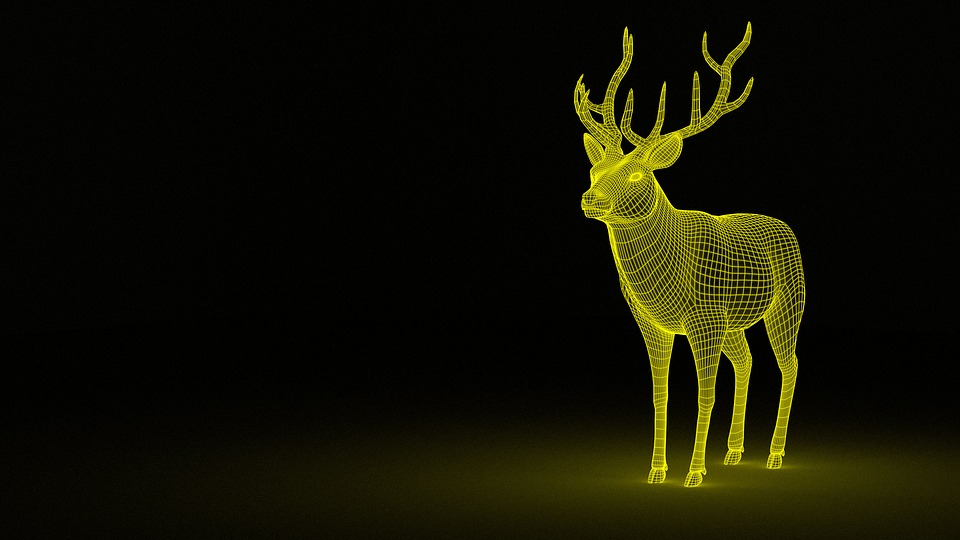Let's Discuss
Enquire NowWhat if you could recreate your pictures into 3D alternatives? Researchers have developed an AI system that could do just that.
The NVIDIA Research team uses a technique called Inverse Rendering, which approximates the characteristics of light, to develop an AI system that could convert a collection of still photos into a digital 3D model in just a matter of seconds. One of the first models of its kind, the method combines ultra-fast neural network training with rapid rendering. They combined this technique with a new technology known as neural radiance fields or NeRF. The end product, known as Instant NeRF, is the quickest NeRF approach to date, capable of achieving speedups of more than 1,000x.
To further understand this technology, let’s start with the basics.
 Image credits: https://pixabay.com/illustrations/deer-dream-animal-fantasy-magic-1333814/
Image credits: https://pixabay.com/illustrations/deer-dream-animal-fantasy-magic-1333814/
What is NeRF?
The name may ring a bell to you as a popular toy gun that may have been your childhood favorite. But in the big boys club, NeRF is way cooler than Nerf.
NeRF, or neural radiance field, is a fully-connected neural network that creates fresh perspectives of intricate 3D sceneries from a limited collection of 2D photos. Using a rendering loss, it has been instructed to duplicate input views of a scene. It functions by interpolating between the input photos of a scene to create a single rendered scene. It is a very efficient method for producing images for artificial data. In order to render new views, a NeRF network is trained to directly map from viewing direction and spatial location (5D input) to opacity and color (4D output). NeRF is a computationally demanding technique, and it might take hours or even days to process complex scenes.
Let’s go over some fundamental concepts in order to comprehend how NeRF functions.
Rendering: The process of producing an image from a 3D model is known as Rendering. The rendering engine’s job is to process the model’s properties to produce a realistic image. The model will have elements like texturing, shading, shadows, lighting, and views.
Three common rendering algorithms:
- Rasterization, which projects objects geometrically based on model data without optical effects.
- Ray casting, which computes an image from a particular point of view using fundamental optical laws of reflection.
- Ray tracing, which employs Monte Carlo techniques to produce a realistic image in a lot less time.
Volume Rendering: A volume rendering algorithm finds the RGBA (Red, Green, Blue, and Alpha channel) for each voxel in the area where the camera’s rays are thrown for a particular camera position. The corresponding pixel of the 2D image receives the RGB color after being transformed to an RGB color. Every pixel is subjected to the same procedure until the full 2D image has been generated.
View Synthesis: The reverse of volume rendering, view synthesis entails building a 3D perspective from a collection of 2D photos. This can be achieved by taking a number of images from various perspectives, creating a hemispheric plan of the object, and positioning each image in the proper location around the object. Given a collection of photos that depict various angles of an item, a view synthesis function tries to forecast the depth.
How does NeRF work?
NeRF accepts input in the form of static image sets. A continuous volumetric scene function is optimized by a NeRF using a small number of input views. This optimization allows for the creation of fresh perspectives of complicated scenes.
A NeRF can be produced by either generating a sampled set of 3D points by marching camera rays through the scene, by producing an output set of densities and colors by feeding your sampled points and the appropriate 2D viewing directions into the neural network, or by utilizing traditional volume rendering techniques to combine your densities and colors into a 2D image.
Depending on the intricacy and resolution of the visualization, it can take hours or longer to create a 3D scene using conventional NeRF techniques. This is where NVIDIA’s Instant NeRF comes into the picture.
Instant NeRF
Instant NeRF drastically reduces the rendering time. It is based on an NVIDIA method known as multi-resolution hash grid encoding, which is designed to function effectively on NVIDIA GPUs. Researchers have developed a novel input encoding technique that allows them to use a small, quick neural network to produce high-quality outputs. This model was created using NVIDIA CUDA Toolkit and the Tiny CUDA Neural Networks library. It can be trained and used on a single NVIDIA GPU due to the fact that it is a lightweight neural network. The NVIDIA Tensor Core cards allow it to operate at its best. By taking 2D pictures or videos of real-world items, the technique might be used to teach robots and autonomous vehicles how to perceive their size and shape. Rapidly creating digital replicas of genuine surroundings that developers can edit and build upon could likewise be employed in architecture and entertainment.
According to David Luebke, vice president for graphics research at NVIDIA, Instant NeRF has the potential to significantly improve the speed, simplicity, and accessibility of 3D capture and sharing, just as digital cameras and JPEG compression have for 2D photography.
For virtual worlds, Instant NeRF could be used to build landscapes or avatars, record video conference participants and their surroundings in 3D, or rebuild scenes for 3D digital maps.
Like NVIDIA, we at Dexlock strive to maintain substantial expertise with the latest technologies in the market. Through our expertise in AI, ML, Structured Light 3D, and other related fields, we offer the best of services to other futurist thinkers looking to make a difference. Have a project like Instant NeRF in mind? Connect with us here to turn your dreams into a reality.
Disclaimer: The opinions expressed in this article are those of the author(s) and do not necessarily reflect the positions of Dexlock.



